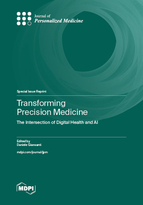Transforming Precision Medicine: The Intersection of Digital Health and AI
A special issue of Journal of Personalized Medicine (ISSN 2075-4426). This special issue belongs to the section "Methodology, Drug and Device Discovery".
Deadline for manuscript submissions: closed (15 November 2023) | Viewed by 36240
Special Issue Editor
Interests: biomedical engineering; robotics; artificial intelligence; digital health; rehabilitation; smart technology; cybersecurity; mental health; animal-assisted therapy; social robotics; acceptance; diagnostic pathology and radiology; medical imaging; patient safety; healthcare quality; health assessment; chronic disease
Special Issues, Collections and Topics in MDPI journals
Special Issue Information
Dear Colleagues,
We are delighted to announce the launch of a Special Issue on “Transforming Precision Medicine: The Intersection of Digital Health and AI”. This Special Issue aims to explore the dynamic interplay between digital health and artificial intelligence (AI) and its transformative impact on the field of precision medicine.
Precision medicine has revolutionized healthcare by tailoring treatments to the unique characteristics of each patient. With the advent of digital health technologies and the advancements in AI, we are witnessing an unprecedented opportunity to further enhance the accuracy, efficiency, and accessibility of personalized healthcare.
This Special Issue provides a platform for researchers, healthcare professionals, and experts in the field to share their insights, innovations, and success stories in utilizing digital health and AI to propel precision medicine forward. We invite original research articles, reviews, and perspectives that shed light on the synergistic potential of these domains and showcase their applications across various healthcare settings.
Topics of interest for this Special Issue include, but are not limited to:
- The role of wearable devices and remote monitoring in precision medicine;
- AI-driven approaches for genomic analysis and precision diagnostics;
- Intelligent algorithms for clinical decision support in precision medicine;
- Applications of telemedicine and digital health platforms in delivering personalized care;
- Ethical considerations and regulatory frameworks for digital health and AI in precision medicine;
- Data privacy and security in the era of interconnected healthcare systems;
- AI-driven precision medicine for specific diseases or populations;
- Real-world case studies demonstrating the impact of digital health and AI on patient outcomes.
By bringing together diverse perspectives and cutting-edge research, this Special Issue aims to foster a deeper understanding of how the convergence of digital health and AI can transform precision medicine. We encourage submissions that present novel approaches, critical insights, and evidence-based outcomes, ultimately driving the field forward.
We invite researchers and practitioners from various disciplines to contribute to this Special Issue and contribute to expanding our collective knowledge in this exciting and rapidly evolving field. Manuscripts can be submitted through our online submission system, and all submissions will undergo rigorous peer review to ensure the highest scientific quality.
We look forward to receiving your contributions and coming together to explore the transformative potential of digital health and AI in revolutionizing precision medicine.
Dr. Daniele Giansanti
Guest Editor
Manuscript Submission Information
Manuscripts should be submitted online at www.mdpi.com by registering and logging in to this website. Once you are registered, click here to go to the submission form. Manuscripts can be submitted until the deadline. All submissions that pass pre-check are peer-reviewed. Accepted papers will be published continuously in the journal (as soon as accepted) and will be listed together on the special issue website. Research articles, review articles as well as short communications are invited. For planned papers, a title and short abstract (about 100 words) can be sent to the Editorial Office for announcement on this website.
Submitted manuscripts should not have been published previously, nor be under consideration for publication elsewhere (except conference proceedings papers). All manuscripts are thoroughly refereed through a single-blind peer-review process. A guide for authors and other relevant information for submission of manuscripts is available on the Instructions for Authors page. Journal of Personalized Medicine is an international peer-reviewed open access monthly journal published by MDPI.
Please visit the Instructions for Authors page before submitting a manuscript. The Article Processing Charge (APC) for publication in this open access journal is 2600 CHF (Swiss Francs). Submitted papers should be well formatted and use good English. Authors may use MDPI's English editing service prior to publication or during author revisions.
Keywords
- precision medicine
- personalized medicine
- genomic medicine
- individualized medicine
- evidence-based medicine
- artificial intelligence
- big data
- digital health







